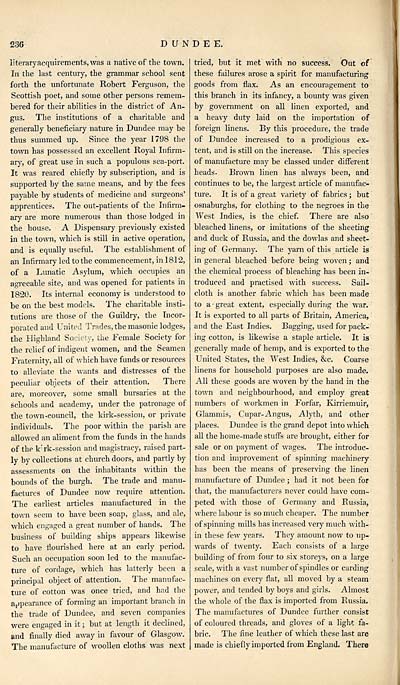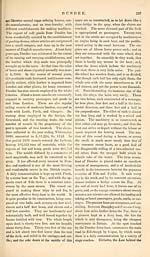Gazetteer of Scotland > Volume 1
(266) Page 236
Download files
Complete book:
Individual page:
Thumbnail gallery: Grid view | List view

23G
DUNDEE.
literaryacquirements,\vas a native of the town.
In the last century, the grammar school sent
forth the unfortunate Robert Ferguson, the
Scottish poet, and some other persons remem-
bered for their abilities in the district of An-
gus. The institutions of a charitable and
generally beneficiary nature in Dundee may be
thus summed up. Since the year 1798 the
town has possessed an excellent Royal Infirm-
ary, of great use in such a populous sea-port.
It was reared chiefly by subscription, and is
supported by the same means, and by the fees
payable by students of medicine and surgeons'
apprentices. The out-patients of the Infirm-
ary are more numerous than those lodged in
the house. A Dispensary previously existed
in the town, which is still in active operation,
and is equally useful. The establishment of
an Infirmary led to the commencement, in 1812,
of a Lunatic Asylum, which occupies an
agreeable site, and was opened for patients in
1820. Its internal economy is understood to
be on the best models. The charitable insti-
tutions are those of the Guildry, the Incor-
porated and United Trades, the masonic lodges,
the Highland Society, the Female Society for
the relief of indigent women, and the Seamen
Fraternity, all of which have funds or resources
to alleviate the wants and distresses of the
peculiar objects of their attention. There
are, moreover, some small bursaries at the
schools and academy, under the patronage of
the town -council, the kirk-session, or private
individuals. The poor within the parish are
allowed an aliment from the funds in the hands
of the k' rk-session and magistracy, raised part-
ly by collections at church doors, and partly by
assessments on the inhabitants within the
bounds of the burgh. The trade and manu-
factures of Dundee now require attention.
The earliest articles manufactured in the
town seem to have been soap, glass, and ale,
which engaged a great number of hands. The
business of building ships appears likewise
to have flourished here at an early period.
Such an occupation soon led to the manufac-
ture of cordage, which has latterly been a
principal object of attention. The manufac-
ture of cotton was once tried, and had the
appearance of forming an important branch in
the trade of Dundee, and seven companies
were engaged in it ; but at length it declined,
and finally died away in favour of Glasgow.
The manufacture of woollen cloths was next
tried, but it met with no success. Out of
these failures arose a spirit for manufacturing
goods from flax. As an encouragement to
this branch in its infancy, a bounty was given
by government on all linen exported, and
a heavy duty laid on the importation of
foreign linens. By this procedure, the trade
of Dundee increased to a prodigious ex-
tent, and is still on the increase. This species
of manufacture may be classed under different
heads. Brown linen has always been, and
continues to be, the largest article of manufac-
ture. It is of a great variety of fabrics ; but
osnaburghs, for clothing to the negroes in the
West Indies, is the chief. There are also
bleached linens, or imitations of the sheeting
and duck of Russia, and the dowlas and sheet-
ing of Germany. The yarn of this article is
in general bleached before being woven ; and
the chemical process of bleaching has been in-
troduced and practised with success. Sail-
cloth is another fabric which has been made
to a • great extent, especially during the Avar.
It is exported to all parts of Britain, America,
and the East Indies. Bagging, used for pack-
ing cotton, is likewise a staple article. It is
generally made of hemp, and is exported to the
United States, the West Indies, &c. Coarse
linens for household purposes are also made.
All these goods are woven by the hand in the
town and neighbourhood, and employ great
numbers of workmen in Forfar, Kirriemuir,
Glammis, Cupar-Angus, Alyth, and other
places. Dundee is the grand depot into which
all the home-made stuffs are brought, either for
sale or on payment of wages. The introduc-
tion and improvement of spinning machinery
has been the means of preserving the linen
manufacture of Dundee ; had it not been for
that, the manufacturers never could have com-
peted with those of Germany and Russia,
where labour is so much cheaper. The number
of spinning mills has increased very much with-
in these few years. They amount now to up-
wards of twenty. Each consists of a large
building of from four to six storeys, on a large
scale, with a vast number of spindles or carding
machines on every flat, all moved by a steam
power, and tended by boys and girls. Almost
the whole of the flax is imported from Russia.
The manufactures of Dundee further consist
of coloured threads, and gloves of a light fa-
bric. The fine leather of which these last arc
made is chiefly imported from England. There
DUNDEE.
literaryacquirements,\vas a native of the town.
In the last century, the grammar school sent
forth the unfortunate Robert Ferguson, the
Scottish poet, and some other persons remem-
bered for their abilities in the district of An-
gus. The institutions of a charitable and
generally beneficiary nature in Dundee may be
thus summed up. Since the year 1798 the
town has possessed an excellent Royal Infirm-
ary, of great use in such a populous sea-port.
It was reared chiefly by subscription, and is
supported by the same means, and by the fees
payable by students of medicine and surgeons'
apprentices. The out-patients of the Infirm-
ary are more numerous than those lodged in
the house. A Dispensary previously existed
in the town, which is still in active operation,
and is equally useful. The establishment of
an Infirmary led to the commencement, in 1812,
of a Lunatic Asylum, which occupies an
agreeable site, and was opened for patients in
1820. Its internal economy is understood to
be on the best models. The charitable insti-
tutions are those of the Guildry, the Incor-
porated and United Trades, the masonic lodges,
the Highland Society, the Female Society for
the relief of indigent women, and the Seamen
Fraternity, all of which have funds or resources
to alleviate the wants and distresses of the
peculiar objects of their attention. There
are, moreover, some small bursaries at the
schools and academy, under the patronage of
the town -council, the kirk-session, or private
individuals. The poor within the parish are
allowed an aliment from the funds in the hands
of the k' rk-session and magistracy, raised part-
ly by collections at church doors, and partly by
assessments on the inhabitants within the
bounds of the burgh. The trade and manu-
factures of Dundee now require attention.
The earliest articles manufactured in the
town seem to have been soap, glass, and ale,
which engaged a great number of hands. The
business of building ships appears likewise
to have flourished here at an early period.
Such an occupation soon led to the manufac-
ture of cordage, which has latterly been a
principal object of attention. The manufac-
ture of cotton was once tried, and had the
appearance of forming an important branch in
the trade of Dundee, and seven companies
were engaged in it ; but at length it declined,
and finally died away in favour of Glasgow.
The manufacture of woollen cloths was next
tried, but it met with no success. Out of
these failures arose a spirit for manufacturing
goods from flax. As an encouragement to
this branch in its infancy, a bounty was given
by government on all linen exported, and
a heavy duty laid on the importation of
foreign linens. By this procedure, the trade
of Dundee increased to a prodigious ex-
tent, and is still on the increase. This species
of manufacture may be classed under different
heads. Brown linen has always been, and
continues to be, the largest article of manufac-
ture. It is of a great variety of fabrics ; but
osnaburghs, for clothing to the negroes in the
West Indies, is the chief. There are also
bleached linens, or imitations of the sheeting
and duck of Russia, and the dowlas and sheet-
ing of Germany. The yarn of this article is
in general bleached before being woven ; and
the chemical process of bleaching has been in-
troduced and practised with success. Sail-
cloth is another fabric which has been made
to a • great extent, especially during the Avar.
It is exported to all parts of Britain, America,
and the East Indies. Bagging, used for pack-
ing cotton, is likewise a staple article. It is
generally made of hemp, and is exported to the
United States, the West Indies, &c. Coarse
linens for household purposes are also made.
All these goods are woven by the hand in the
town and neighbourhood, and employ great
numbers of workmen in Forfar, Kirriemuir,
Glammis, Cupar-Angus, Alyth, and other
places. Dundee is the grand depot into which
all the home-made stuffs are brought, either for
sale or on payment of wages. The introduc-
tion and improvement of spinning machinery
has been the means of preserving the linen
manufacture of Dundee ; had it not been for
that, the manufacturers never could have com-
peted with those of Germany and Russia,
where labour is so much cheaper. The number
of spinning mills has increased very much with-
in these few years. They amount now to up-
wards of twenty. Each consists of a large
building of from four to six storeys, on a large
scale, with a vast number of spindles or carding
machines on every flat, all moved by a steam
power, and tended by boys and girls. Almost
the whole of the flax is imported from Russia.
The manufactures of Dundee further consist
of coloured threads, and gloves of a light fa-
bric. The fine leather of which these last arc
made is chiefly imported from England. There
Set display mode to: Large image | Transcription
Images and transcriptions on this page, including medium image downloads, may be used under the Creative Commons Attribution 4.0 International Licence unless otherwise stated. ![]()
| Gazetteers of Scotland, 1803-1901 > Gazetteer of Scotland > Volume 1 > (266) Page 236 |
|---|
| Permanent URL | https://digital.nls.uk/97427554 |
|---|
| Description | Volume I: Abbey to Glenartney. |
|---|---|
| Attribution and copyright: |
|
| Description | By Robert Chambers and William Chambers. Glasgow: Blackie & Son, 1838. 2 volumes. |
|---|---|
| Shelfmark | NF.1461.g.7 |
| Additional NLS resources: | |

